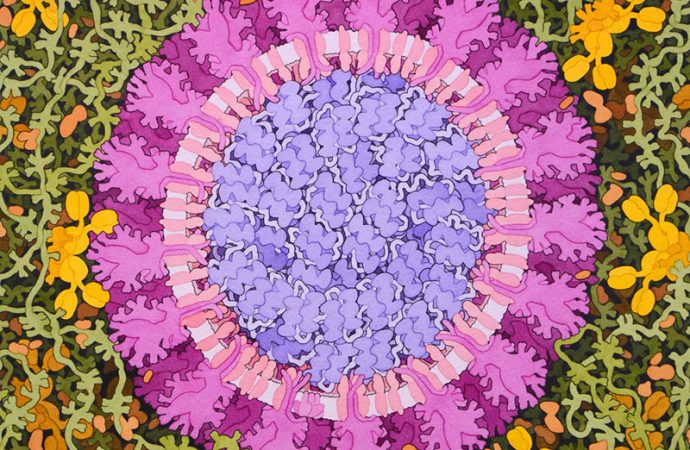Now that we are all tuned into virus talk, it may be a good idea to shed new light on an old debate. Arguments about whether viruses are alive have gone on for years. Expert opinion remains divided roughly a third each between yes, no and don’t know (surveys conducted by Vincent Racaniello on Virology Blog). Many researchers cop-out by saying things like “they are on the boundary of life”. The answer, of course, has as much to do with how we define life as it does with the nature of viruses.
An ill-defined life
School textbooks commonly provide a list of attributes for living organisms, such as reproduction, metabolism, among others. Viruses fulfil a few of these, but so do some things that no biologist would call life. For example, fire can reproduce itself and, in a way, it has a metabolism (burning fuel, releasing energy, using that energy to maintain its own persistence).
Biologists counter by demanding the ability to evolve (nothing in biology can be understood unless in the light of evolution…). But evolution by natural selection is an inevitable consequence of variation and competitive reproduction under resource scarcity: it has been demonstrated with hypothetical mixtures of chemicals (Hordijk et al., 2012) and nobody has yet cried “It’s alive!”.
Since the 1960s, a whole academic and engineering industry has built up around mimicking life in software: artificial life. It is not hard to write a program that can reproduce itself with just the right amount of variation to allow useful evolution and for instances of the program to ‘move’ and interact in their virtual world. But these cybernetic entities have no metabolism, nor do they have bodies, because they are not material things.
Chemical machinery
Viruses are material, they act in the real physical world and do reproduce and evolve -to our consternation! For the last seventy years, or so, most biologists have understood life as chemistry (Kornberg, 1991). By no means any chemistry though, since it is a bewilderingly complex system of exquisitely precise interlocking molecular-scale machine parts that makes life. The bits and pieces: chemical switches, relays and actuators, nano-scale fabricators and tiny dynamos, all work together in tight coordination (beautifully illustrated by David Goodsell, 2009).
Life is necessarily dynamic and organised, but not regimented; it is complex and constantly changing, but not chaotic. In fact, life combines both the real-world chemistry and the cyber-world organisation to produce self-regulating complex networks that have such organisational control over themselves that they achieve autonomous agency. It is this self-making autonomy that is currently thought to be the most profound and unique attribute of life.
The ability of a system to literally make itself sounds like a logical paradox, but it is something every living cell does, whether it is in your body or is a single bacterium floating in a pond. This astonishing feat is captured in the theory of autopoiesis developed during the 1970s by Chilean scientists Humberto Maturana and Francisco Varela. At its heart is the special organisation of a system that works to maintain its organisation. This means circular causation, in which things are, even more paradoxically, the cause of themselves. Such weirdness becomes more accessible if we understand what causation is.
In the physical world, only physical forces can (proximally) cause things to happen, but, without the constraint of the forces, in direction and strength, they produce no more than the pressure of a gas or plasma (which is what keeps stars from imploding). Constraint imposes organisation and the organisation enables forces to act in concert to do real work, just as the walls of a piston chamber enable hot steam to work The Flying Scotsman by constraining the pressure to release in one direction only.
Constrained organisation
Much cleverer than a steam train, living things harness constrained forces to make their component parts and order them in an arrangement that is … themselves. These constraints are nothing more than the particular placement of atoms and molecules – put them here and not anywhere. Since this imposes a specific configuration, it greatly reduces the entropy (which is a measure of the freedom to rearrange a configuration).
Anything that reduces entropy instills information – they are the converse of one another. Indeed, there is a direct, mathematical relationship between the particularity of a configuration and the information it embodies. Organisms are very rich in this sort of functional information; it got there by molecular-scale pattern matching. In effect, then, life is information processing: it is an algorithm running, not on a silicon chip, but on wet chemistry. Molecular biologist Denis Bray termed it “wetware” because it is simultaneously the program and the soggy hardware.
As you can imagine, an algorithm that is also the substrate upon which it runs, and for which the output is literally itself, is very special indeed. To do all that requires the astonishing property of circular causation, taken to such an extent that the whole system is “closed to efficient causation”, meaning that it has, within itself, all the organisation that it needs to come into being.
What about viruses?
So, finally, we come to the clinching deficit among viruses that disqualifies them from things that can be ‘alive’. They do not have within themselves enough organising information to make themselves: they are not autopoietic systems.
That is much more than saying they are obligatory parasites like liver flukes are. Living parasites only need external resources from their host. Viruses require their host to provide missing internal organisation because they are not themselves, organisationally whole. They are information parasites because their algorithms are incomplete.
So are viruses alive? No.
Image Credit: David S. Goodsell, RCSB Protein Data Bank; doi: 10.2210/rcsb_pdb/goodsell-gallery-019
References and further reading
www.whatlifeis.info
www.virology.ws/
Bray, D. Wetware: a computer in every living cell. (2009). Yale University Press, New Haven, USA.
Cárdenas, M.L., Letelier, J.C., Gutierrez, C., Cornish-Bowden, A., Soto-Andrade, J. (2010). Closure to efficient causation, computability and artificial life. J. Theor. Biol. 263, 79–92.
Farnsworth, K. D., Nelson, J., Gershenson, C. (2013). Living is Information Processing: From Molecules to Global Systems. Acta Biotheor. 62: 203-222.
Goodsell, D. S. (2009). The Machinery of Life. Springer, New York.
Hordijk, W., Steel, M., Kauffman, S. (2012). The Structure of Autocatalytic Sets: Evolvability, Enablement, and Emergence. Acta Biotheoretical 60:379–392 DOI 10.1007/s10441-012-9165-1
Kauffman, S.A. (1993). Origins of Order: Self-Organization and Selection in Evolution; Oxford University Press: Oxford, UK.
Kornberg, A. (1991). Understanding life as chemistry. Clinical Chemistry, 37(11):1895–1899.
Montévil, M. and Mossio, M. (2015). Biological organisation as closure of constraints. J. Theor. Biol., 372:179–191, 2015.
Rosen, R. (1991). Life itself: A comprehensive enquiry into the nature, origin and fabrication of life; Columbia University Press: New York, USA.
Varela, F. J., Maturana, H., Uribe, R. (1974). Autopoiesis: the organisation of living systems, its characterisation and a model. BioSystems, 5:187-196.





